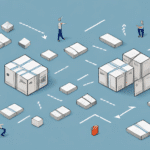A Comprehensive Overview and Features of 3PL Logistics Fulfillment
In today's fast-paced and ever-changing business landscape, companies are often challenged to efficiently manage their supply chain and logistics. Third-party logistics (3PL) fulfillment has emerged as a popular and effective solution for businesses requiring a comprehensive and integrated approach to their logistics operations. This article provides a detailed overview of 3PL logistics fulfillment, including the basics, benefits, different types of providers, selecting the right provider, and more. Let's dive in and explore the breadth of 3PL logistics fulfillment.
Understanding the Basics of 3PL Logistics Fulfillment
3PL stands for third-party logistics, which refers to the outsourcing of logistics and supply chain operations to a specialized provider. These providers offer a range of services, including transportation, warehousing, order fulfillment, inventory management, and more. 3PL logistics companies possess the expertise, technology, and infrastructure to efficiently manage these operations.
The primary objective of 3PL logistics fulfillment is to streamline the supply chain, making it more efficient and cost-effective for businesses. By outsourcing logistics operations, companies can focus on their core competencies while the 3PL provider handles logistics, potentially reducing operational costs by up to 15% according to industry studies.
Why Choose 3PL Logistics Fulfillment for Your Business?
There are several reasons why businesses choose 3PL logistics fulfillment:
- Cost Savings: 3PL providers have the expertise and resources to manage logistics operations efficiently, allowing companies to save on operational costs.
- Scalability: Businesses can scale their logistics operations up or down based on demand without significant investments in infrastructure.
- Flexibility: 3PL providers offer customized solutions tailored to the unique requirements of businesses.
- Improved Efficiency: Advanced technology and streamlined processes enhance supply chain efficiency.
- Enhanced Customer Satisfaction: Faster and more reliable deliveries lead to higher customer satisfaction and loyalty.
According to a Forbes study, businesses utilizing 3PL services have seen a 10-20% increase in supply chain efficiency. 3PL logistics fulfillment providers offer advanced technology and software that streamline the entire logistics process, including real-time tracking of shipments, inventory management, and automated order processing. These tools enhance supply chain visibility, enabling data-driven decisions to optimize operations. Additionally, 3PL providers often have a vast network of carriers and warehouses, offering faster and more cost-effective shipping options to businesses.
The Advantages of Outsourcing Logistics Fulfillment to a Third-Party Provider
Outsourcing logistics fulfillment to a 3PL provider offers numerous advantages:
- Efficiency: 3PL providers optimize the supply chain, managing logistics operations around the clock to ensure accurate and timely order fulfillment.
- Cost Savings: By outsourcing, businesses can avoid fixed costs associated with owning and managing warehouses, transportation, and staff.
- Expertise and Technology: 3PL providers bring specialized knowledge and advanced technologies to optimize the supply chain, improving efficiency and reducing costs.
- Market Expansion: 3PL providers' global networks enable businesses to expand their reach and enter new markets with ease.
- Risk Management: 3PL providers help mitigate risks related to logistics operations, such as compliance and security issues.
Companies that partner with 3PL providers experience an average of 30% faster delivery times, enhancing customer satisfaction and loyalty, as reported by a recent McKinsey report.
Exploring the Different Types of 3PL Logistics Providers
3PL providers come in various types, each specializing in different aspects of logistics fulfillment:
- Freight Forwarders: Specialize in the transportation of goods across different modes and international borders.
- Courier and Express Delivery Services: Focus on fast, time-sensitive deliveries.
- Transportation Providers: Manage the movement of goods via road, rail, air, or sea.
- Warehousing and Distribution Companies: Handle the storage, management, and distribution of inventory.
- Customs Brokers: Manage the customs clearance process for international shipments, ensuring compliance with regulations.
- Value-Added Logistics Providers: Offer additional services such as assembly, packaging, labeling, and product customization.
Understanding the specific services each type of 3PL provider offers is crucial for selecting the right partner that aligns with your business needs.
How to Choose the Right 3PL Logistics Provider for Your Business
Choosing the right 3PL provider is essential to achieving your logistics goals. Consider the following factors during the selection process:
- Expertise and Experience: Evaluate the provider's experience in your industry and their track record in managing similar logistics operations.
- Technology and Infrastructure: Ensure the provider utilizes advanced technology such as warehouse management systems (WMS) and transportation management systems (TMS).
- Cost-Effectiveness: Analyze the provider's pricing structure to ensure it aligns with your budget and offers value for money.
- Location and Network: Consider the provider's geographic reach and network of warehouses and carriers to support your distribution needs.
- Customer Service: Assess the provider's customer service and communication capabilities to ensure a smooth working relationship.
- Scalability: Choose a provider that can scale their services as your business grows and your logistics needs evolve.
For instance, a provider with robust experience in the food industry will understand the specific requirements for handling perishable goods and adhering to food safety standards, as highlighted in Harvard Business Review.
The Role of Technology in 3PL Logistics Fulfillment
Technology is a critical component in modern 3PL logistics fulfillment. Advanced solutions such as warehouse management systems (WMS), transportation management systems (TMS), and order management systems (OMS) help 3PL providers streamline operations and improve efficiency. These technologies offer real-time visibility into inventory levels, order statuses, and shipment tracking, enabling businesses to make informed, data-driven decisions.
Additionally, automation and robotics are increasingly being utilized in 3PL operations. Automated systems like conveyor belts, robotic picking systems, and automated storage and retrieval systems reduce the time and labor required to manage goods within warehouses. This not only enhances operational efficiency but also minimizes errors and damages. According to a Supply Chain Digital report, the adoption of automation in 3PL warehouses has increased by 25% in the past year.
Furthermore, technologies like GPS tracking, real-time delivery updates, and mobile applications are enhancing the customer experience by providing greater visibility and control over shipments. This level of transparency is essential in today's competitive e-commerce market, where customers expect fast and accurate deliveries.
Key Features to Look for in a 3PL Logistics Provider
When selecting a 3PL provider, consider the following key features to ensure efficient logistics fulfillment:
- Advanced Technology: The provider should utilize state-of-the-art logistics technologies to streamline operations and provide real-time visibility.
- Scalability and Flexibility: The ability to scale services according to your business growth and adapt to changing logistics needs.
- Transparency: Clear communication and transparency in operations, including real-time tracking and reporting.
- Quality Control: Robust quality control measures to ensure accuracy and reliability in order fulfillment.
- International Capabilities: Expertise in international logistics, including customs regulations and cross-border transportation.
- Commitment to Sustainability: Sustainable practices such as eco-friendly packaging, optimized transportation routes, and energy-efficient warehouse operations.
Prioritizing these features will help you choose a 3PL provider that not only meets your current needs but also supports your future growth and sustainability goals.
Tips for Successfully Implementing a 3PL Logistics Solution
Implementing a 3PL logistics solution requires careful planning and coordination. Here are some tips for successful implementation:
- Define Your Logistics Goals: Clearly outline your logistics objectives and communicate them effectively to the 3PL provider.
- Establish Effective Communication: Set up regular communication channels and establish clear expectations for performance and reporting.
- Develop a Strong Partnership: Build a collaborative relationship with your 3PL provider to ensure alignment and mutual support.
- Monitor Performance: Regularly evaluate the provider's performance against set metrics to ensure continuous improvement.
- Provide Training and Support: Ensure that both your team and the provider’s team are adequately trained on the systems and processes involved.
Successful implementation of a 3PL solution can lead to significant improvements in operational efficiency and customer satisfaction.
Measuring the Success of Your 3PL Logistics Fulfillment Strategy
To measure the success of your 3PL logistics fulfillment strategy, establish clear metrics and benchmarks aligned with your logistics goals. Key performance indicators (KPIs) to monitor include:
- Order Accuracy: The percentage of orders delivered without errors.
- On-Time Delivery: The percentage of orders delivered on schedule.
- Cost Efficiency: The reduction in logistics costs achieved through 3PL services.
- Inventory Accuracy: The accuracy of inventory levels maintained by the 3PL provider.
- Customer Satisfaction: Feedback and satisfaction levels from your customers regarding delivery and service quality.
Utilize data analytics and reporting tools to continuously monitor these KPIs and identify areas for improvement. Regular evaluations help ensure that the 3PL provider is meeting your expectations and contributing to your business's success.
Common Challenges and Solutions in 3PL Logistics Fulfillment
While 3PL logistics fulfillment offers numerous advantages, businesses may encounter challenges such as:
- Cost Management: Managing and controlling logistics costs can be difficult without clear visibility.
- Maintaining Quality Control: Ensuring consistent quality in order fulfillment is crucial for customer satisfaction.
- Meeting Customer Expectations: Fast and accurate deliveries are essential to meet evolving customer demands.
To overcome these challenges:
- Set Clear Expectations: Define performance standards and communicate them clearly to the 3PL provider.
- Implement Monitoring Tools: Use tracking and reporting tools to maintain visibility over logistics operations.
- Foster Open Communication: Maintain regular communication with the provider to address issues promptly.
- Regular Performance Reviews: Conduct periodic evaluations to assess performance and make necessary adjustments.
Proactively addressing these challenges helps businesses maximize the benefits of their 3PL logistics fulfillment partnership.
Future Trends and Innovations in 3PL Logistics Fulfillment
The 3PL logistics industry is continuously evolving, driven by technological advancements and changing market dynamics. Future trends and innovations to watch include:
- Automation and Robotics: Continued integration of automated systems and robotics to enhance efficiency in warehouses and distribution centers.
- Artificial Intelligence (AI) and Machine Learning: AI-powered analytics for predictive forecasting, route optimization, and personalized customer experiences.
- Internet of Things (IoT): Enhanced connectivity and real-time data sharing through IoT devices, improving supply chain visibility and responsiveness.
- Blockchain Technology: Increased use of blockchain for secure and transparent transactions, reducing fraud and improving traceability.
- Sustainability Initiatives: Greater emphasis on eco-friendly practices, such as electric delivery vehicles and sustainable packaging solutions.
These innovations are set to transform 3PL logistics fulfillment, making it more efficient, transparent, and sustainable.
Case Studies: Real-Life Examples of Successful Implementation of 3PL Logistics Solutions
Examining real-life case studies provides valuable insights into the benefits and challenges of 3PL logistics fulfillment. Notable examples include:
- Amazon: By partnering with 3PL providers, Amazon has optimized its logistics network, enabling rapid order fulfillment and expanding its global reach.
- Walmart: Walmart utilizes 3PL services to enhance its supply chain efficiency, ensuring timely inventory replenishment and distribution across its vast network of stores.
- DHL: DHL's collaboration with 3PL providers has allowed it to offer comprehensive logistics solutions, catering to diverse customer needs worldwide.
These case studies demonstrate how leveraging 3PL logistics fulfillment can lead to significant improvements in operational efficiency, cost savings, and customer satisfaction.
Conclusion: The Importance of Effective and Efficient 3PL Logistics Fulfillment
In conclusion, effective and efficient 3PL logistics fulfillment is crucial for businesses aiming to optimize their supply chain and achieve their logistics goals. By outsourcing logistics operations to a 3PL provider, businesses can save time and money, improve scalability and flexibility, and gain access to specialized expertise and advanced technologies.
To maximize the benefits of 3PL logistics fulfillment, it is essential to select the right provider, establish effective communication channels, and regularly monitor performance to ensure continuous improvement. With the right strategy and approach, 3PL logistics fulfillment can drive long-term success and help businesses stay competitive in today's dynamic market.








